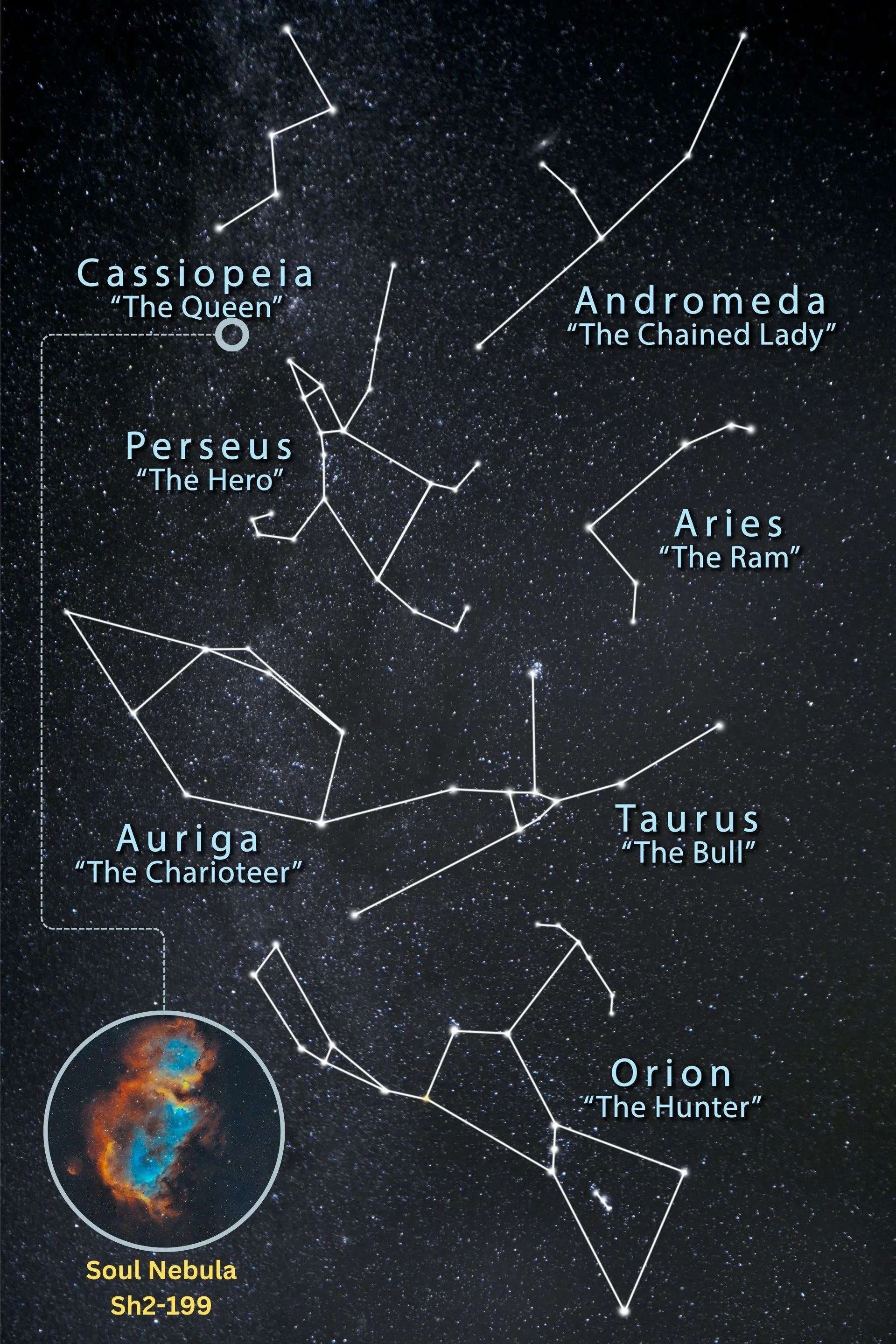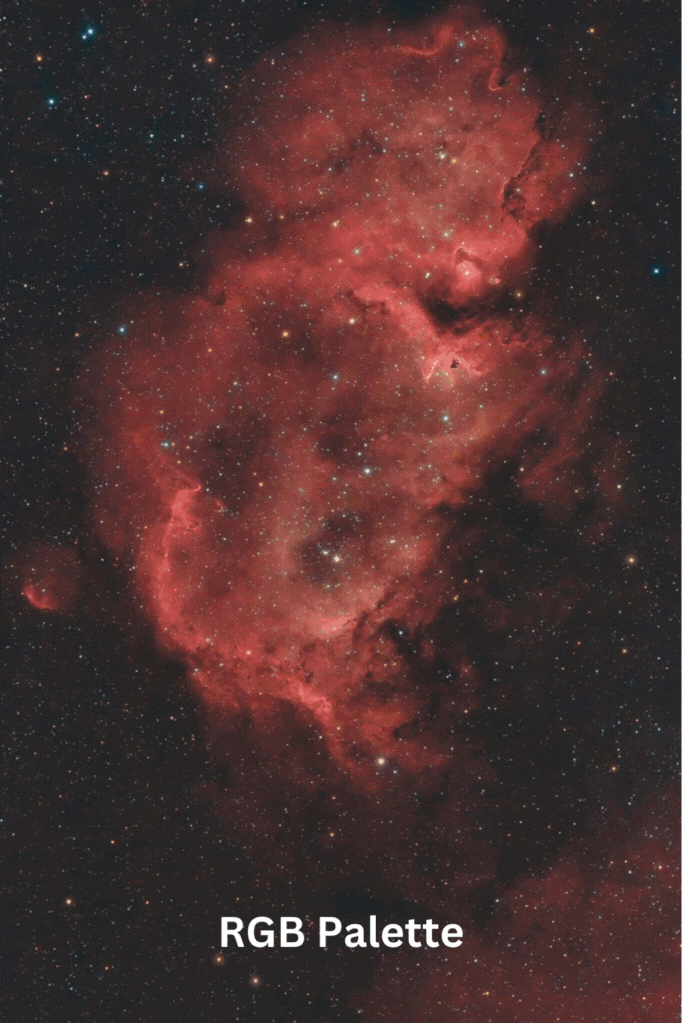The Night Sky - Episode 12
THE SOUL NEBULA
This is episode 12 in my series on our night sky.
The universe is a vast canvas painted with galaxies, stars, and celestial wonders that captivate our imagination. Let's embark on a cosmic journey to discover the secrets of a breathtaking celestial object, the Soul Nebula, known for its rich colours and ethereal beauty.
An image of the Soul Nebula (Sh2-199). Over 15 hours of faint light from deep space were captured to create this image.
Image by Achint Thomas
The Soul Nebula, designated Sh2-199 and IC 1848, is a stunning emission nebula located approximately 7,500 light-years from Earth. Measuring approximately 300 light-years across, the Soul Nebula is a sizable cosmic entity. Its vastness is complemented by its luminosity, making it a brilliant beacon in the night sky when viewed with the appropriate equipment.
The nebula's age is estimated to be around 1 million years, relatively young in cosmic terms. It owes its appearance to the presence of hot, massive stars nearby. Like many other nebulae, the Soul Nebula is a stellar nursery where new stars are born from the surrounding gas and dust. The immense gravitational forces exerted by dense molecular clouds can initiate the collapse of these clouds, leading to the formation of new stars. As these young stars ignite, their intense radiation bathes the surrounding gas in ultraviolet light, causing it to glow and giving rise to the beautiful and intricate structures seen in the nebula.
Cassiopeia: Where the Soul Nebula Resides
The Soul Nebula is located in the constellation Cassiopeia, a region teeming with astronomical delights.
Location of the Cassiopeia constellation in the night sky. The Soul Nebula (Sh2-199) is located near this constellation.
Image by Achint Thomas
Positioned close to Cassiopeia's well-known "W" shape, the Soul Nebula is easily identifiable and a prized target for astrophotographers and stargazers alike.
The Soul Nebula (Sh2-199) is located near the constellation of Cassiopeia.
Image by Achint Thomas
Close to the Soul Nebula, you will find another stunning nebula known as the Heart Nebula (IC 1805). The Heart Nebula is another emission nebula, similarly illuminated by young, hot stars, and it is also a region of active star formation. Together, the Heart and Soul Nebulae create a compelling and romantic cosmic pair, inviting us to explore the depths of the universe.
Read more about the Heart Nebula in my episode on this wonderously shaped region in space.
Ann annotated image of the region around the Heart and Soul Nebulae.
Image by Achint Thomas
The close proximity of the Soul and Heart Nebulae makes them a popular combined target for astrophotographers. Capturing both nebulae in a single frame can provide a breathtaking view of the cosmic love story happening in our galaxy.
The Foraxx Palette
Astrophotographers often employ various techniques to capture the stunning beauty of celestial objects like the Soul Nebula. One such technique is false-colour imaging, which involves assigning specific colours to different wavelengths of light to reveal hidden details and structures that may not be apparent in natural colour images.
In the case of emission nebulae, using a specialized colour palette known as the "Hubble Palette" or "Hubble Palette" has become popular among astrophotographers. The Hubble Palette assigns specific colours to hydrogen, sulphur, and oxygen emissions, typically mapping hydrogen to green, sulphur to red, and oxygen to blue. This technique enhances the visual contrast and reveals the intricate structures within the nebula, allowing astrophotographers to create stunning, vibrant images that capture the essence of this cosmic wonder.
An alternative false-colour palette that has gained popularity among astrophotographers is the "Foraxx" palette. This palette allows astrophotographers to highlight cosmic regions in various pastel shades to create images that beautifully balance the portrayal of celestial objects and the cosmic environment.
The Sould Nebula rendered in various palettes.
Image by Achint Thomas
In astrophotography, choosing a false-colour palette is a creative decision the photographer makes, offering the opportunity to showcase celestial objects in unique and captivating ways. It is a form of artistic expression that brings out the hidden beauty of the universe and allows us to appreciate its wonders in a new light.
In the cosmic symphony of stars, the Soul Nebula stands as a testament to the artistry of the universe. Its celestial embrace and the stories it tells of stellar creation invite us to ponder the cosmic poetry written in the night sky. Through astrophotography, the Soul Nebula continues to inspire, reminding us of the immeasurable beauty waiting to be discovered in the boundless expanse of space.
Check out some other nebulae I have captured.
Capture details
Camera: Astro-modified Canon 80D
Lens: Sigma 100-400mm f/5-6.3 DG OS HSM
Focal length: 250mm (equivalent to 400mm full-frame)
f-Ratio: 6.3
ISO: 800
Number of exposures: 305 total
- 205*180s with Astronomik Hα filter
- 100*180s with Optolong L-Enhance filter
Total integration time: ~8.6 hours over 4 sessions
Calibration frames: 30 darks, 30 flats, 30 bias for each session
Mount: SkyWatcher Star Adventurer
Guide camera: ZWO 120mm mini
Guide scope: ZWO Mini Guide scope
Capture control: ZWO ASIAir Pro
Dew control: CooWoo dew heater
Sky quality: Bortle 5
Moon phase: Various from 30% to 90%
Processing: PixInsight, Photoshop






